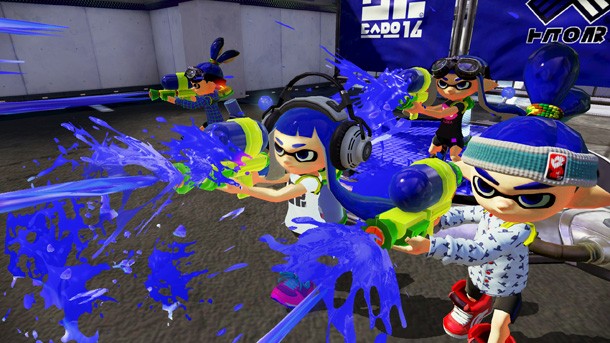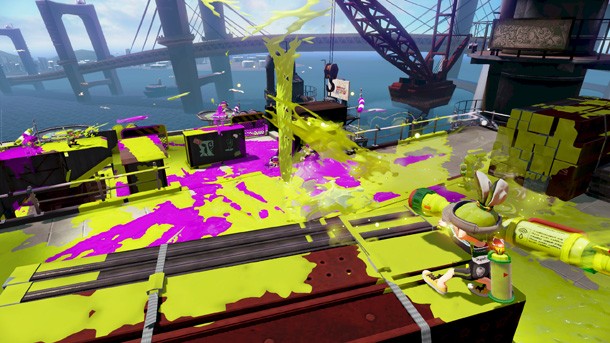Splatoon Interview – It Couldn't Be Mario, It Had To Be Squids

At E3 this year, we had the opportunity to speak with some of the creative minds behind Nintendo’s new third-person shooter, Splatoon. Producer Hisashi Nogami’s history with Nintendo involves working on Yoshi’s Island on Super Nintendo, as well as games like Animal Crossing. Co-director Tsubasa Sakaguchi made character designs for The Legend of Zelda: Twilight Princess, and worked most recently on Nintendo Land, before taking on his first directorial role on Splatoon.
We asked them about the development process of the game, what it’s like to build a new IP for Nintendo, and why the game’s mechanics couldn’t have worked with an established Nintendo franchise.
Note: translations for responses from Nogami and Sakaguchi came from a single translator making it difficult to attribute exactly who said what.
 What goes into the process of making a totally new game within Nintendo?
What goes into the process of making a totally new game within Nintendo?
The very start of this project was our boss, Kazumi Yamaguchi, got about 10 of us together with the idea of creating a new game. So, those 10 people got together and we were all individually coming up with different ideas, making different kinds of experiments, just trying to come up with as much new stuff as we could.
Among those people on the team, there was Shintaro Sato, a programmer for Splatoon, who created a program where it was just a four-on-four teams – white blocks and black blocks – and they would just shoot ink out to try and cover as much as possible. It was a territory control game.
We played that and we thought it was really fun so we brought it to Mr. Yamaguchi for presentation, and also Mr. Miyamoto. We had a few back and forths, a few more presentations, and we finally decided yeah, this should be a full game.
That’s just the case with Splatoon, though. Throughout EAD there are always lot of prototypes and experiments being made. It would be hard to say this is the defined process for creating a game, but that’s definitely how it worked with Splatoon. Along the way, there is always a step where Mr. Miyamoto, Takashi Tezuka, or Mr. Yamaguchi takes a look at it and gives it an ok, and that means, “Yeah, we’re going to go and make a full game.” And Mr. Miyamoto, he knows this game very well.
I’ve heard that experimental ideas within Nintendo typically get placed into established IP. Were the Splatoon mechanics ever considered for use with an established Nintendo IP?
With us, first we’re making the game, and then we think what kind of characters we would use with it, and obviously, one of those choices is established IP.
Of course, the most important thing is what matches. What matches with the gameplay and the abilities you are giving to the player, the play style, and ultimately what graphically will match the game you want to make. In the case of this game, we found that it really had to be new characters to would fit this game we were making. It would be kind of weird if Mario got splattered with ink and then exploded.
What about Super Mario Sunshine? Mario dealt with ink and fired liquid from a hose in that game.
Yeah, but it’s not like he blew up or anything [laughs].
First we started with the ability to shoot ink but then we added the ability to swim really fast through it, and as we kept adding more abilities to what the player was able to do, there was this kind of moment where we all realized, “Oh yeah, this would work really well with squids.”
Making them squids, it made a lot of the actions easy to explain and also made it really fun, and it was also this idea where all the actions we wanted to include in the game could be built around the idea of squids to get them all in there.
You can see all our existing IP on this Smash Bros. poster right here [there was a Smash Bros. poster in the interview room]. When we had a really good long think about, would one of those fit it? Or should this new squid idea be the way to go? we realized squids were definitely the only thing we could go with. If the Wii Fit Trainer would have been the perfect character for this game, we would have gone with the Wii Fit Trainer [laughs].
For more on Splatoon's development cycle, head to page two.

I understand how you landed on squids for Splatoon, but I’m curious what the next step is. How do you get a new IP and new characters through the ranks of Nintendo?
There was actually a huge period of time between where we started thinking squids might be a good idea, to the point where we actually decided to go with squids. That process might be more interesting.
Even at the time of that prototype, there was the ability to hide in the ink – squash down in it. At that time, we weren’t describing it as diving into the ink. You just kind of got squashed down into it. But then, in order to make the hide in your own ink ability more useful, we started adding other abilities, like the ability to move very quickly through the ink. That was the kind of thing that started to make us think maybe the squids would be better. That’s where we kind of came up with this concept about making the game about switching between the person and being a squid. When you’re a person you can shoot the ink, everyone can see you, and you’re moving a little bit slowly. When you’re a squid, you’re fast and you can hide, and you can charge up your ink, but you can’t do any attacking.
When we decided to make the game about switching, we got a really good reaction and we were having a lot of fun playing the game. While we were thinking about the mechanics and player abilities, our art director was coming up with assorted character designs. We had – right from the beginning – all these different ideas, the squids being one of them. We had robots, different animals, macho men, and Mario – existing IP. Right from the start we had all these different choices.

The art director was making lots of different sketches and designing lots of different characters. As we were adding more and more abilities, everything came to a head with the visuals that we were thinking of and the abilities we were giving the players. We realized: squids! And that allowed us, in terms of world building, that to explain things to the player in a different way. It used to be, when you were in the ink you just moved fast, but now we could explain it as you were swimming. Before, the player just sort of squished down into the ink, but now we could have them dive in. From there, the sound directors and the people working in the graphics were able to add the sound effects and the wake you leave behind while swimming that make it the game you see today.
Rather than the squids being the first domino – the new game, the new IP – it was more like we were creating the whole way and the squid was a piece over on the side, and it became the final piece we put in.
Third-person shooters are an atypical genre for Nintendo. There are certain expectations for shooters. For example, I struggled without a reticle and the sensitivity seemed high.
We are definitely going to have options, the ability to turn the gyro off, and the ability to adjust the stick sensitivity. Obviously, the controls aren’t completely fixed so we can’t say they are going to be exactly like this.
The mechanics are much different from any other shooter, but are you looking at comparable games for direction or inspiration regarding the controls?
Obviously, when we’re not at work, we’re gamers and we play a lot of games. We love to play games. There are definitely a lot of people on the staff who play shooters and love them, but there are also people who don’t play shooters. I don’t want to say that we’re influenced by them, but we are aware of these games and we definitely have that knowledge In our heads. We play these games and sometimes we think, “Maybe it would be better if it was like this,” and we definitely have those ideas inside our heads.

I wouldn’t say there was any one game in particular that we were looking at, but because we are playing these games, to an extent we have these ideas in our heads. As we are here making our own game, and trying to make it the game we want, if there is anything we think “Oh, I want it to be like this,” it is probably present in the game. We’re certainly influenced in some way – you can’t help it – but there is nothing specific where we said, “We want to do an improved version of this.” It’s not like we’re trying to imitate any games specifically, but I think the fact that we’re making a game like this shows that we respect those other games.
Will there be a campaign or a story? I would like to learn more about these characters, which was something I wasn’t really getting just playing multiplayer.
Ultimately, we’re looking at getting Splatoon out as a full retail packaged software in the first half of 2015. Our plans are to create, maybe for the benefit of the people who cannot connect online, a single-player mode and a local one-on-one mode.
One player on television, one on GamePad?
We’re still wrestling with exactly how we want to do it, but it will probably be one person on GamePad, one on pro controller.
For our hands-on impressions with Splatoon, head here to read a conversation between myself and Jeff Cork.

Get the Game Informer Print Edition!
Explore your favorite games in premium print format, delivered to your door.
- 10 issues per year
- Only $4.80 per issue
- Full digital magazine archive access
- Since 1991









